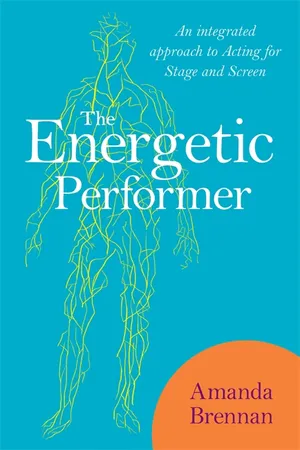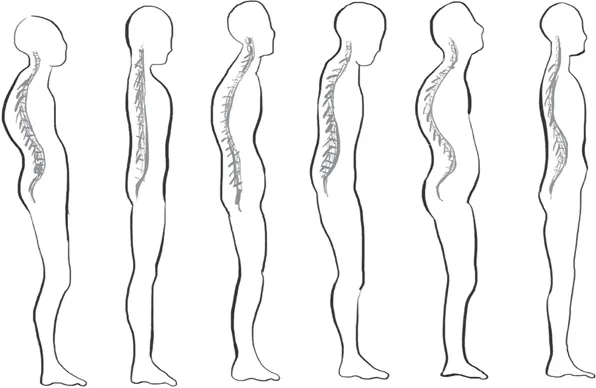![]()
Part 1
ACTORS AND THEIR INNER LIFE
![]()
Chapter 1
YOU
A place to begin the work
Introduction
The starting point for the work of an actor is their own body. It is the primary resource which is used to transition into fictional worlds. Having the facility to be available and as freely expressive as possible is a goal which seems both essential and valuable. The approach encouraged throughout this book is one which emphasises the importance of knowing and understanding your body. We all have a certain amount of awareness, and the aim here is to deepen this, to suggest where to begin or to where we need to return.
There are amazing stories present in your body, all of which reveal the clues and mysteries of who you are and how your past has shaped your present. Understanding yourself opens the gate to accessing and drawing on your own experiences as the fundamental component of creative work. Each one of us is fascinating, with the depth of an ocean. At your disposal is an instrument from which you can both utilise the familiar and shift into the unknown.
With the recognition of the complex layers within the body comes the possibility to sharpen receptivity and broaden your imaginative range. Nothing creatively interesting will occur unless you learn how to play, respond with spontaneity and move from what is familiar into a creative place where anything is possible. Just as your body is your resource, it can also be your obstacle, and to be able to use it like an artist uses clay or a musician a range of notes, there needs to be an investment in working to facilitate the possibilities. The premise is that you are the material from which to build.
In this chapter I look at how the shape of our body has emerged and consider the broader contextual influences. I want to identify what it means to become aware and what to actually notice. This starts with the layers and structures within, your breath, thoughts and vitality, and the idea that by tuning in to changes and transitions you can feel more connected to your own instrument.
Your body shape
Let’s look at the whole body as if it is a piece of carved architecture. The shape has not emerged accidentally but rather has been influenced by a response to the joys, pleasures, intellectual tasks, creative pursuits, traumas and shocks. It articulates needs and expresses the relationship to deepest desires, and to a large extent defines identity. Your shape affects how you interface with and are received by others. It is clear to recognise that an open and relaxed body tends to be easier to access and respond to than one which is taut and rigid, as there is less defence. If we look at stereotypical perceptions of body composition, strict and controlling characters, such as dictators or army generals, are usually stiff and inflexible; angels and heroines are soft and slight, and baddies are either huge, twisted or disfigured. Body shape reveals the clues to the traits and qualities of a person.
The outer shape that has evolved through a lifetime has implications for the many shapes inside, as the two work hand in hand. Literally, the organisation of organs, bones and the endless lengths of veins and arteries that form the cardiovascular system, the intricate web of the nervous system which passes messages and stimulates impulses, are all organised into a neatly packed structure. It is like a jigsaw puzzle, with every piece integrated and ideally fitting together to create one complete vibrant landscape through which the rivers of sensation and emotion run. As there are no static moments within a living body, the scene constantly changes and realigns in reaction to the stimulus encountered. During life, layer after layer of experience is laid down and stored, and what is visible to the eye is the surface of a very deep canyon. As Stanley Keleman suggests:
Life makes shapes. These shapes are part of an organising process that embodies emotions, thoughts and experiences into a structure. (Keleman 1985, p.xi)
There are two aspects to body shape: one that is visible (the gestures and movement patterns which form outer expression); and one that is all that is inside (the inner world, the physiological action which creates feelings, emotions and every impulse which flows). Both aspects are completely intertwined. Figure 1.1 shows how the shape of the spine moulds the external structure.
Figure 1.1 Row of bodies (courtesy of Amy Stevens)
Returning to your body as the starting point, there is a lot to consider. Transitions into imaginative worlds affects every molecule, as you continually alter in composition. The given circumstances activate the terrain of the canyon, stirring up changes which instantaneously and truthfully occur. The more the circumstances are believed, the more responsive is the landscape. A significant factor in the freedom to allow for internal change to occur is structure, as it affects the space provided for physiological systems to function. Just like when a pipe is twisted water will not pass, the same applies to the flow of sensation, the range of emotions, the passage of thoughts as well as the quality and amount of energy cultivated to take action.
The acting process involves forming new bodily patterns and the cultivation of fresh vibrations, which may stimulate feelings sometimes beyond what is comfortable or familiar. How often have you read a script and thought that you would never behave in that way (e.g. you would not kill or bully someone or run naked through a street)? The task of the actor is to make the leap and create an authenticity which is believable. As we all have personal patterns and a repertoire of expression, this leap at times may be difficult to achieve. It is natural to have a range of behaviours, but some territory will be new; for example, occasionally you may get angry but never furious; should the scene require fury, you are entering into the unfamiliar. Making a real departure from what is known pushes boundaries, and fury may feel unsafe or unreachable so would require letting go and moving through obstacles that you may not want to experience. This makes physiological adaptability and awareness integral to an actor’s craft.
How your shape emerged
Clearly a person evolves through the journey of life, and changes occur according to age and events. There are also some key determinants that define shape, such as genetics and hereditary factors. The chances are that you will inherit some or many of your parents’ or grandparents’ features, and this may be anything from your height to a frown or the length of your fingers. There are, however, many other considerations which have an effect on your body composition. Let’s start by outlining the ways in which shape can impact on your work.
Shape and your work
How you are shaped obviously affects:
•the way you literally move
•the distribution of your weight
•how you use the space around you
•the gestures you make
•the freedom with which you communicate
•how you relate to others.
The shapes within your body affect:
•your range of sensations and feelings
•the emotions with which you express yourself
•your ability to have a sense of your whole body
•the level of energy you have.
Other influences
Sociocultural
The family you are born into plays a significant role in what you will experience and how you perceive yourself. Social class determines the opportunities available regarding a multitude of things, the most fundamental being food and nourishment. On a broader level it influences educational experience, the range and types of pastimes available, the groups of people with whom you interact and the ideologies adopted. What you are exposed to will ultimately inform what you consider to ...

